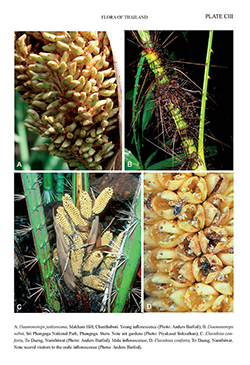e-Flora of Thailand
Volume 11 > Part 3 > Year 2013 > Page 402 > Arecaceae > Daemonorops
6. Daemonorops jenkinsiana (Griff.) Mart.wfo-0000937060
Hist. Nat. Palm. 3: 327. 1853; Evans et al., A Field Guide to the Rattans of Lao PDR: 68. 2001.— Calamus jenkinsianus Griff., Calcutta J. Nat. Hist. 5: 81. 1845.— Palmijuncus jenkinsianus (Griff.) Kuntze, Revis. Gen. Pl. 2: 733. 1891. Plate CIII: A.
Accepted Name : This is currently accepted.
Synonyms & Citations :
Description : Clustering moderate-sized to robust rattan tending to form dense thickets. Stems to 25 m or more long, but often flowering when much less, without sheaths 1.5–3 cm diam., with sheaths 3–6 cm diam., internodes 25–40 cm long. Leaves cirrate; sheaths dull green to pale brown, with abundant reddish to dark brown indumentum and armed with abundant scattered and grouped black spines, the largest flattened, 3–4 cm long, interspersed with smaller less obviously flattened spines 0.3–2 cm long, the spines sometimes arranged in partial whorls; knee conspicuous, armed as the rest of the sheath, although sometimes less densely so; ocrea minute, scarcely developed; petiole 10–50 cm long, much longer in juvenile stems and rosette leaves, armed abaxially and along margins with black spines 0.2–1 cm long; rachis to 2 m long, armed as the petiole; cirrus 50–90 cm long; leaflets to 70 or more on each side of the rachis, regularly arranged, linear, the largest 30–70 by 1.5–3.8 cm, bristly along 3 nerves adaxially, along margins, and along midrib abaxially. Inflorescences erect, ± sessile, or peduncle very short, not exceeding 6 cm long, the male and female superficially similar, but the male branched to 3 orders and the female to 2 orders, the whole infl orescence to ca 65 cm long, rarely more, 15 cm wide, smaller in impoverished stems; prophyll boat-shaped with a beak to 7–15 cm long, and densely armed with black spines and abundant dark indumentum, enclosing the entire inflorescence with all its bracts, the prophyll splitting at anthesis but bract tips usually remaining captured within the tip of the prophyll; rachillae very densely crowded, male to 3 by 0.2 cm, female to 8 by 0.3 cm. Mature fruit rounded, ca 1.9 cm diam., with a short beak to 0.15 by 0.15 cm, and covered in 17–18 vertical rows of yellowish-brown, channelled scales with darker margins. Seed rounded ca 1.3 cm diam.; endosperm deeply ruminate. Seedling leaf with ca 8 closely set linear leaflets.
Thailand : NORTHERN: Mae Hong Son, Chiang Mai, Chiang Rai, Nan, Lamphun, Lampang, Phrae, Tak, Phitsanulok; NORTH-EASTERN: Phetchabun; EASTERN: Nakhon Ratchasima; SOUTH-WESTERN: Ratchaburi; CENTRAL: Saraburi, Nakhon Nayok; SOUTH-EASTERN: Chon Buri, Chanthaburi, Trat.
Distribution : E Himalaya (type) and S China to Indochina.
Ecology : Lowland rain forests, below 900 m alt., locally common in gaps and secondary forests.
Vernacular : Wai som khao (หวายโสมเขา)(Trat).
Uses: Edible shoots and leaves used as thatch; the cane is low quality but nevertheless used for basketry and furniture.
Conservation Status: Not threatened.
Notes: For general comments on section Daemonorops to which this species belongs see D. angustifolia.

